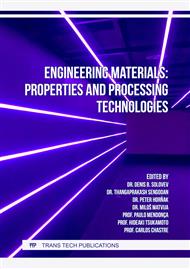[1]
G. Rajeshkumar, S. Arvindh Seshadri, G.L. Devnani, M.R. Sanjay, Suchart Siengchin, J. Prakash Maran, Naif Abdullah Al-Dhabi, Ponmurugan Karuppiah, Valan Arasu Mariadhas, N. Sivarajasekarf, Environment friendly, renewable and sustainable poly lactic acid (PLA) based natural fiber reinforced composites – A comprehensive review, Journal of Cleaner Production. Vol. 310 (2021) 127483.
DOI: 10.1016/j.jclepro.2021.127483
Google Scholar
[2]
Kotiba Hamada, Mosab Kaseemb, Muhammad Ayyoob, Jinho Joo, Fawaz Deri, Polylactic acid blends: The future of green, light and tough, Progress in Polymer Science. Vol. 85 (2018) pp.83-127.
DOI: 10.1016/j.progpolymsci.2018.07.001
Google Scholar
[3]
M.V. Podzorova, A.A. Popov, Y.V. Tertyshnaya, Environmentally friendly films based on poly(3-hydroxybutyrate) and poly(lactic acid): a review, Russian Journal of Physical Chemistry B. Т. 8, № 5 (2014) 726-732.
DOI: 10.1134/s1990793114050078
Google Scholar
[4]
Y. Tertyshnaya, M. Podzorova, M. Moskovskiy, Impact of water and UV irradiation on nonwoven polylactide/natural rubber fiber, Polymers. 13(3) (2021) 1-10, 461.
DOI: 10.3390/polym13030461
Google Scholar
[5]
D. da Silva, M. Kaduri, M. Poley, O. Adir, N. Krinsky, J. Shainsky-Roitman et al. Biocompatibility, biodegradation and excretion of polylactic acid (PLA) in medical implants and theranostic systems, Chem Eng J. 340 (2018) 9–14.
DOI: 10.1016/j.cej.2018.01.010
Google Scholar
[6]
A. Shebi, S. Lisa, Pectin mediated synthesis of nano hydroxyapatite-decorated poly (lactic acid) honeycomb membranes for tissue engineering. Carbohydr Polym. 201 (2018) 39–47.
DOI: 10.1016/j.carbpol.2018.08.012
Google Scholar
[7]
A.C. da Silva, T. Augusto, L.H. Andrade, S.I. Cordoba de Torresi, One pot biocatalytic synthesis of a biodegradable electroactive macromonomer based on 3,4-ethylenedioxytiophene and poly(l-lactic acid). Mater Sci Eng C Mater Biol Appl. 83 (2018) 35–43.
DOI: 10.1016/j.msec.2017.09.007
Google Scholar
[8]
E. Al Tawil, A. Monnier, Q.T. Nguyen, B. Deschrevel, Microarchitecture of poly(lactic acid) membranes with an interconnected network of macropores and micropores influences cell behavior, Eur Polym J. 105 (2018) 370–388.
DOI: 10.1016/j.eurpolymj.2018.06.012
Google Scholar
[9]
Y.V. Tertyshnaya, A.A. Popov, Hydrolytic degradation of polylactide in distilled water and seawater, Polym. Sci. Ser. D. 13(3) (2020) 306–310.
DOI: 10.1134/s1995421220030211
Google Scholar
[10]
Y.V. Tertyshnaya, M.V. Podzorova, Effect of UV Irradiation on the Structural and Dynamic Characteristics of Polylactide and Its Blends with Polyethylene, Rus. J. Phys. Chem. B. 14 (2020) 167–175.
DOI: 10.1134/s1990793120010170
Google Scholar
[11]
T. Ohkita, Thermal degradation and biodegradability of poly(lactic acid), corn starch biocomposites, Journal of Applied Polymer Science. № 100 (2006) 3009-3017.
DOI: 10.1002/app.23425
Google Scholar
[12]
E.S. Trofimchuk, M.A. Moskvina, N.I. Nikonorova, A.V. Efimov, E.S. Garina, T.E. Grokhovskaya, O.A. Ivanova, A.V. Bakirov, N.G. Sedush Hydrolytic degradation of polylactide films deformed by the environmental crazing mechanism, European Polymer Journal. Vol. 139 (2020) 110000.
DOI: 10.1016/j.eurpolymj.2020.110000
Google Scholar
[13]
Kim Hyong Su, KR 20120108147 (2011).
Google Scholar
[14]
Park Seo Jin [Kr], Kim Dong Wook [Kr], Kr 20110139425 (2010).
Google Scholar
[15]
Y. Wang, M.A. Hillmyer, Polyethylene-poly(L-lactide) diblock copolymers: synthesis and compatibilization of poly(L-lactide), polyethylene blends, J. Polym. Sci. A Polym. Chem. 39 (2001) 2755–2766.
DOI: 10.1002/pola.1254
Google Scholar
[16]
K.S. Anderson, M.A. Hillmyer, The influence of block copolymer microstructure on the toughness of compatibilized polylactide/polyethylene blends, Polymer. 45 (2004) 8809–8823.
DOI: 10.1016/j.polymer.2004.10.047
Google Scholar
[17]
N. Reddy, D. Nama, Y. Yang, Polylactic acid/polypropylene polyblend fibers for better resistance to degradation, Polym. Degrad. Stab. 93 (2008) 233–241.
DOI: 10.1016/j.polymdegradstab.2007.09.005
Google Scholar
[18]
H.-S. Kim, H.-J. Kim, Miscibility and performance evaluation of natural-flour-filled PP/PBS and PP/PLA bio-composites, Fibers Polym. 14 (2013) 793–803.
DOI: 10.1007/s12221-013-0793-0
Google Scholar
[19]
M.V. Podzorova, Y.V. Tertyshnaya, P.V. Pantyukhov, L.S. Shibryaeva, A.A. Popov, and S. Nikolaeva, AIP Conf. Proc. 1783 020185 (2016).
DOI: 10.1063/1.4966479
Google Scholar
[20]
L.-T. Lim, R. Auras, M. Rubino, Prog. Polym. Sci. 33 820-852 (2008).
Google Scholar
[21]
Q. Zhou, M. Xanthos, Polym. Degrad. Stab. 93 (8) 1450-1459 (2008).
Google Scholar
[22]
M.V. Podzorova, Y.V. Tertyshnaya, P.V. Pantyukhov, L.S. Shibryaeva, A.A. Popov, and S. Nikolaeva, Influence of ultraviolet on polylactide degradation, in International Conference on Advanced Materials with Hierarchical Structure for New Technologies and Reliable Structures, AIP Conference Proceedings. 1909 (2017) 020173.
DOI: 10.1063/1.5013854
Google Scholar
[23]
L.S. Shibryaeva, M.V. Podzorova, Yu.V. Tertyshnaya and M.E. Chaplygin Agricultural materials based on eco-friendly polymers, 2020 IOP Conf. Ser.: Mater. Sci. Eng. 971, 032022.
DOI: 10.1088/1757-899x/971/3/032022
Google Scholar


